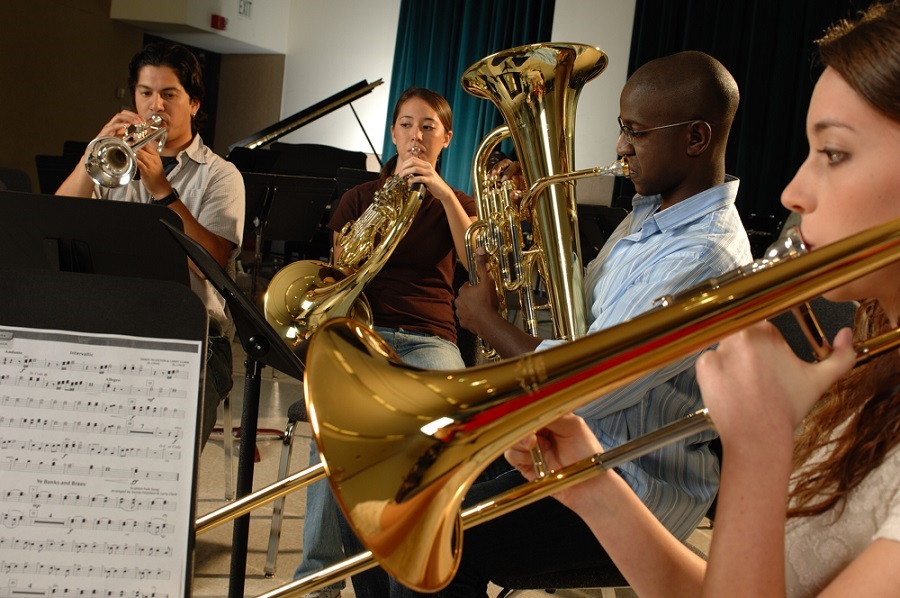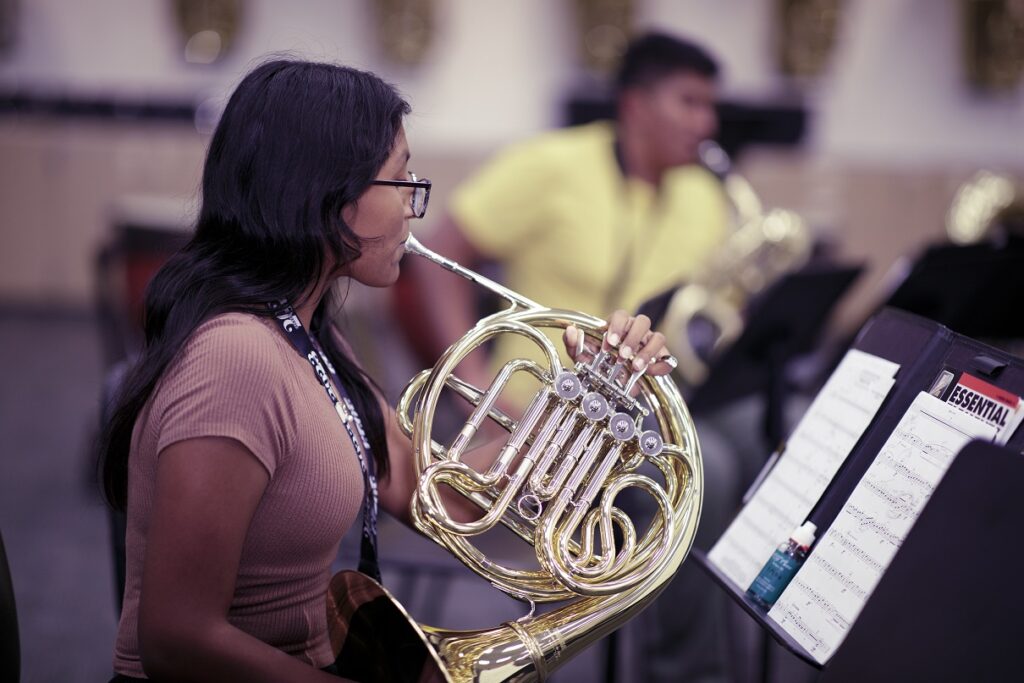Daily Diet of Fundamentals
In preparing for a contest, spend more time on fundamentals at first so students can strengthen skills to achieve a high level of performance.
A musician’s daily diet or daily drill provides all the necessary basics for performing on an instrument successfully. While it’s not a perfect formula, at Claudia Taylor Johnson High School, we stick to our daily drill in the same way that we brush our teeth or get dressed for school each day — we make it a part of our routine.
Like a balanced nutritional diet, we work on fundamental exercises each day that strengthen the skills our students need to achieve a high level of performance. In the earlier parts of contest preparation, we invest more time on fundamentals and less on practicing contest literature. The time focused on fundamentals allows students to develop skills that will make learning the music easier and address weaknesses in our ensemble.
 Fundamentals include all elements of the daily diet for the contest literature, including rhythm training, ear training, breathing exercises, buzzing for brass, long tones, lip flexibilities, harmonic slurs, articulation exercises, range builders, dynamic control exercises, scales, chorales, tuning sequences and more.
Fundamentals include all elements of the daily diet for the contest literature, including rhythm training, ear training, breathing exercises, buzzing for brass, long tones, lip flexibilities, harmonic slurs, articulation exercises, range builders, dynamic control exercises, scales, chorales, tuning sequences and more.
If a contest is in March or April, you will likely begin preparing in January. Here is a suggested structure:
-
- In January, spend 60% of rehearsal time on fundamentals, 40% on music.
- In February, spend 40% of rehearsal time on fundamentals, 60% on music.
- In March and April, spend 20% of rehearsal time on fundamentals, 80% on music.
The table below shows how to split time during a 40-, 60-, and 80-minute class period on fundamentals vs. music and how that time should shift over the course of content preparation.
Class Length |
January (60% — 40%) |
February (40% — 60%) |
March-April (20%— 80%) |
| 40 minutes | 24 fundamentals, 16 music | 16 fundamentals, 24 music | 8 fundamentals, 32 music |
| 60 minutes | 36 fundamentals, 24 music | 24 fundamentals, 36 music | 12 fundamentals, 48 music |
| 80 minutes | 48 fundamentals, 32 music | 32 fundamentals, 48 music | 16 fundamentals, 64 music |
At the end of the day, “right notes and rhythms” go a long way toward a magical musical performance. If students do not have enough time to practice the music during class, they certainly will not be successful during the performance. In general, students practice more efficiently when a teacher structures it, so class rehearsal time becomes critical.
Investing in fundamental skills early on during contest preparation will make working on the music more accessible. Additionally, if you spend time warming-up each day, consider that time as fundamental skill development more than just a warm-up for the day. Long tones can help develop listening skills side-to-side and learning to play with a beautiful sound. Scales help develop students’ sensitivity to matching style and articulation side-to-side and section-to-section, rather than just learning individual notes. The directors who use fundamental warm-ups to develop ensemble skills and not only individual skills will find that their groups begin to take on a resonance and uniformity of sound that enhances all of the music your students perform together.
Daily Drill Essentials
With so many possible uses of fundamentals time, it is easy to get overwhelmed and wonder what to cover in a day. To avoid randomness in our warm-ups or skipping over an essential part of a musician’s diet, we insist on a few things in our fundamentals each day:
-
- Breathing
- Singing
- Long tone
- Lip slur brass/Harmonic slur woodwinds (or woodwinds can do a technique accompaniment)
- Articulation exercise
 If we only have time for a very short warm-up, it must include a sustained long-tone exercise: a Remington/interval study or major/minor scales. It also must include a lip slur exercise for brass (either a soft, slow slur or something quick) and a harmonic slur for woodwinds. Sometimes we will have our woodwinds play a fast finger/technical exercise while the brass plays slurs for efficiency. And finally, the daily drill must include something to work tonguing and style. This could be multiple tonguing, fast tonguing or even learning to control accents, tenutos, staccatos or other styles students will need to succeed.
If we only have time for a very short warm-up, it must include a sustained long-tone exercise: a Remington/interval study or major/minor scales. It also must include a lip slur exercise for brass (either a soft, slow slur or something quick) and a harmonic slur for woodwinds. Sometimes we will have our woodwinds play a fast finger/technical exercise while the brass plays slurs for efficiency. And finally, the daily drill must include something to work tonguing and style. This could be multiple tonguing, fast tonguing or even learning to control accents, tenutos, staccatos or other styles students will need to succeed.
You might consider a breathing sequence that students perform every day — like in four out four, in four out eight, in two out eight, in one out eight at different tempos — rather than just creating something different each day. Additionally, singing can be as basic as a single note or five notes of a scale. Ultimately, we use breathing and singing to develop those skills in a vacuum and raise a student’s awareness about how they feel when they take a proper breath and how something sounds when it is in tune. If students can learn to think about how they feel or how they want something in the room to sound, it increases the chances that they will do this more when they start to perform music.
With additional time, you might explore advanced exercises, including dynamic control exercises, pitch bends for brass, range builders, or other rhythm and ear training exercises. A more extended fundamentals period provides more options. When you need the basics, prioritize the daily drill that works best. And remember, students become easily distracted outside the band class, so it is better to organize their daily drill/warm-up than leaving it in their own hands. If you do it as part of your class routine, you’ll know it is getting done properly.
Long tones or slurs first? I have had great brass teachers weigh in on this debate. Many believe that flow studies and slurs should be done first to move around on the instrument early in the warm-up. Others say that long tones done before slurs will enable fluidity for the day. Ultimately, you can try both or consider mixing it up. At Claudia Taylor Johnson, we have flipped back and forth over the years. Currently, we are in a “flexibility and fluidity first phase,” and we are choosing to do moving slurs early in the warm-up before our sustained exercises.
Daily Drill Must Support Your Contest Program
 While we don’t try to “teach to the test” at Claudia Taylor Johnson, we structure our fundamentals/daily drill to address the skills needed for our performers to play our contest program at a high level. If we know that we are working on Borodin’s “Polovtsian Dances” and a lot of the piece is in the key of concert A major, then we will structure our daily drill with a lot of exercises and chorales in that tonal/key center. Band students spend a lot of time in the keys of concert Bb, Eb, F or Ab major, so playing in A major takes them out of their comfort zones. Working long tone patterns and articulation exercises in A makes the uncomfortable more normal for students. They learn tuning tendencies on their instruments and how to control “bad notes” during fundamentals, making it easier when they work through challenges in their music.
While we don’t try to “teach to the test” at Claudia Taylor Johnson, we structure our fundamentals/daily drill to address the skills needed for our performers to play our contest program at a high level. If we know that we are working on Borodin’s “Polovtsian Dances” and a lot of the piece is in the key of concert A major, then we will structure our daily drill with a lot of exercises and chorales in that tonal/key center. Band students spend a lot of time in the keys of concert Bb, Eb, F or Ab major, so playing in A major takes them out of their comfort zones. Working long tone patterns and articulation exercises in A makes the uncomfortable more normal for students. They learn tuning tendencies on their instruments and how to control “bad notes” during fundamentals, making it easier when they work through challenges in their music.
Another example, if you are working on Sousa’s “The Black Horse Troop,” you would be wise to practice daily drill rhythmic patterns in 6/8. You could do long tones or scales using rhythmic patterns from the march to help develop both counting and articulation skills. Anytime you can transfer complex rhythms from your contest literature into your fundamentals, you double the time your students develop those skills to achieve success.
Using time in class each day to address fundamental skill concerns will improve your ensemble’s performance. Like a sports car that requires daily maintenance and fine-tuning or the human body that needs a balanced diet to live a healthy life, your band will thrive with the proper daily drill that addresses your performers’ needs. A basic structure can still look different each day to avoid your fundamentals from becoming monotonous and tedious. Your students will improve over time by working on skills and not just their contest literature.
















